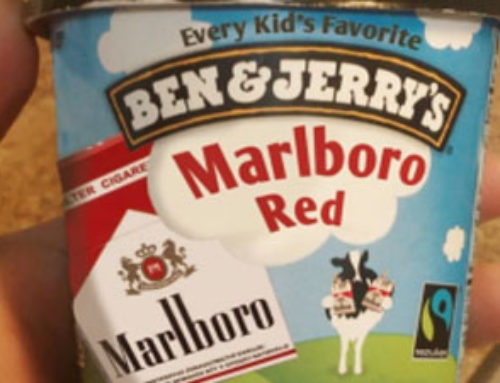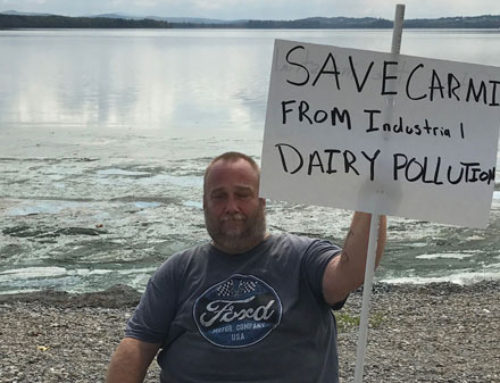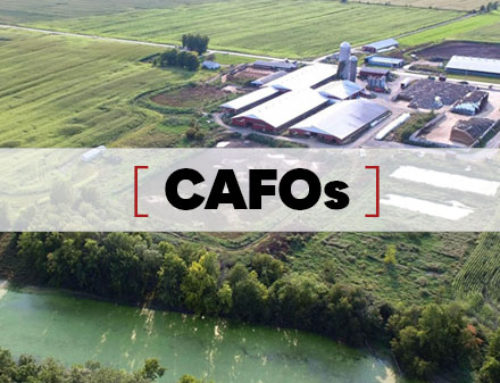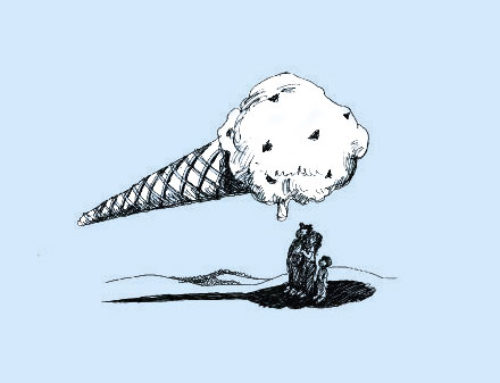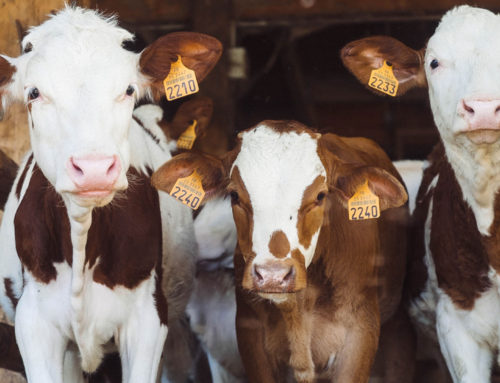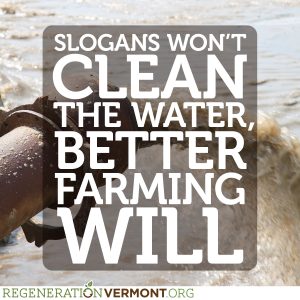
The State of Vermont is on the verge of implementing “Phase One” of its plan to clean up Lake Champlain and the dozens of other impaired waterways throughout the state. In some of the most polluted areas – Missisquoi Bay, for example – the byproducts and techniques currently used by industrial dairy farmers are responsible for nearly 80% of the problem. Statewide, it’s estimated that nearly half of Vermont’s water woes are caused by these commodity-based dairies.
So you’d think Phase One of a plan to clean up these waterways would put an equal amount of emphasis on addressing the obvious causes, the ways of the industrial dairy farm: animal confinement and overcrowding, annual tillage of corn crops, fields left fallow and open through the winter and spring, and toxic fertilizers and pesticides. But you’d be wrong.
In the end, Phase One is little more than what the state has been doing for decades: throwing slogans at it. “Clean & Clear!” they shouted for years, before the EPA came in and called their bluff. And now they’ve got the Clean Water Act and the Clean Water Fund and a big old Phase One of just more of the same, letting large dairy farmers off the hook and counting on the debunked method of dilution as the solution to pollution.
Certain parts of Lake Champlain are literally choking from the cyanobacteria, filled with phosphorus and nitrogen-rich farm runoff, and in serious danger of becoming dead zones. But Phase One trumpets an “assimilation” plan that allows the runoff to continue – only in, hopefully, smaller amounts.
And when will we see results from this strategy of a little less pollution over a whole lot of time? “It is reasonable to assume,” the EPA writes in a response to a comment submitted about the plan, “that it will be, at a minimum, 10-15 years before changes should be expected to be seen in the lake…[but]…the full time-frame could easily be 30 years or more for Missisquoi Bay.”
Instead of really putting the clamp down on the confined animal feeding operations (CAFOs) and the other large dairies that are causing the water problems, the mantra of Phase One is “All In,” as in: it’s everybody’s problem now and we all need to start cleaning up. But this “all in” slogan would be more believable, not to mention persuasive, if there was first a plan to curtail the manure, fertilizer and pesticide issues that have caused the problem up until now. Sure, let’s be “all in,” but first we’ve got to get industrial, nonorganic dairying “all out.”
No one clings to the “all in” slogan more than Chuck Ross, Vermont’s Secretary of Agriculture. At a recent public hearing that unveiled the specifics of Phase One, Ross must have said it in every other sentence. “I can’t emphasize it enough,” he said at one point, already having done so, “but we’ve all got to be ‘all in.’”
It’s like he trashed his house and then invited us all over for dinner. But, before we eat, Chuck would like us all to pitch in and clean up. Oh, and after that, would you invitees mind putting the steaks on the grill? All in!
Instead of trying to share the blame that rests squarely on the shoulders of industrial dairying, Ross and the rest of the state leadership should be taking the initiative in solving the problem. The crown jewel of Vermont’s natural beauty is on life support, so there’s little time for yet another yawning round of sloganeering or blame sharing.
And the best news is that the solution is not only at hand but attainable: Begin the transition – statewide – to organic, regenerative dairy farming. I believe Ross and his government colleagues would find a lot of support for that kind of “all in” approach, one that really seeks to address the causes AND puts Vermont agriculture on a new path we can all be proud of.
First and foremost, it would be about getting Vermont to farm the way it’s marketed: humanely, justly, and ecologically. A far cry from the way we’re actually farming, after decades of adopting an industrial model that is rich in toxic inputs and poor in ecological care. What’s worse, today’s industrial dairying is economic suicide – if not complete exploitation.
Vermont’s nonorganic dairy producers are literally paying to sell their milk today. The average price for commodity milk has been stuck at around $14 a hundredweight (cwt) for months, while it costs about $22 to produce that same milk. For the average Vermont dairy farm of around 125 cows, that translates to losing more than $100,000 a year.
The writing is on the wall, with even Ross’s predecessor pitching in with the scribbling. Vermont’s former secretary of agriculture, Roger Allbee, has recently joined the chorus of reality singers, those of us who know that the industrial dairying show must end.
“Vermont’s conventional dairy farmers need to change their business model…[and]…move quickly with initiatives to emulate what Denmark is doing by becoming an organic milk-producing state,” wrote Allbee, in a widely circulated essay recently.
Allbee took his philosophical transition toward organic agriculture public at the state’s unveiling of its Phase One water cleanup plan. He rose to testify, and addressed his successor, Chuck Ross, directly. Allbee’s been a part of too many of those kinds of dog and pony shows, with the slogans and slides flying about, and the tired bureaucrats trying to act convinced of their own rhetoric.
“Now is the time to act,” Allbee intoned, declaring that if the state really wanted to clean up the waterways, it had to first address how the state farms. Speaking of organic, Allbee continued: “Capitalizing on a brand identity for dairy linked to wholesome and healthy food and environmental compliance while having more predictable pricing is a laudable and achievable objective, I submit.”
But Chuck Ross shouldn’t have to wait until he’s left office to speak the obvious, like Allbee did. He can take action now, and get his agency involved in the rapidly expanding movement calling for a statewide transition to organic, regenerative agriculture. It can be his legacy. And it won’t just clean up the lake, it’ll save Vermont agriculture.
All in, indeed, for organic dairy.
